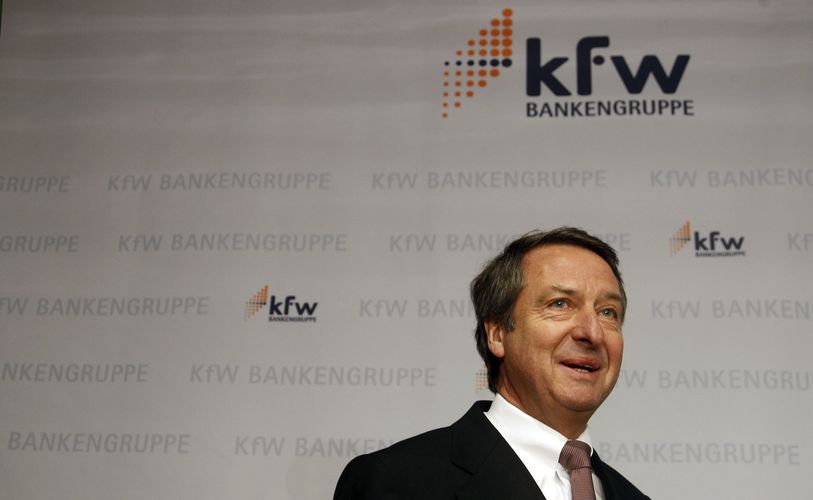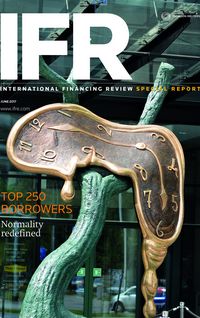German government-owned development bank KfW undoubtedly benefited from PSPP, but continued to broaden its investor base and doubled its Green issuance programme.
KfW proved its global versatility in the capital markets as it funded across 14 separate currencies and displayed an ability to respond swiftly to shifting investor flows.
The German government-owned development bank prides itself on being investor-led and funds in three major currencies – euros, US dollars and sterling. During 2016, it enjoyed a natural funding advantage as its benefited directly from the European Central Bank’s PSPP bond-buying programme. It barely missed a beat against a slew of political upheaval, whether the UK’s vote to leave the European Union in June or the election of President Trump in November.
The PSPP programme pushed government paper into negative territory, and in many cases KfW’s bookrunners had to work hard to get deals with some of the tightest prints on record. The bank itself increased the size of transactions to boost liquidity.
In May 2016, it received more than €7.5bn of demand for the first five-year negative-yielding SSA benchmark, pricing the €5bn deal at -0.196%, 22bp through mid-swaps.
Petra Wehlert, head of capital markets at KfW, said: “This was a highlight for us as it was the first one we’d done in that size with a negative yield. This, for me, was the proof that we had arrived in the world of negative rates.”
With pricing and liquidity guaranteed at home, it was perhaps no surprise that KfW saw an opportunity to diversify its funding sources, and demand was just as strong overseas.
The ECB’s QE programme and negative rates made US dollars the currency of choice for yield-hungry international investors throughout 2016, and KfW followed the money despite the good pricing on the euro side, in its over-arching mission to broaden its investor base.
“We are a global issuer and we follow our international investors - and they preferred the US dollar market,” said Wehlert.
The German agency also succeeded in broadening its investor base. While central banks continued to account for around 60% of deals, bank treasuries in particular increased their share because KfW is considered to be a liquid level one asset. At the same time, it increased its sterling programme with a record £5bn of issuance in the currency during 2016.
But the US dollar market was king, with KfW tapping it for more than half of its €72bn-equivalent funding plan in calendar year 2016. The sheer depth of liquidity in the US suits KfW’s funding strategy, which is to print large-volume benchmark deals of between €3bn and €5bn, aiming for size rather than squeezing the last basis point out of funding.
“They are an international issuer and know they can get the volume they want by paying a premium,” said one syndicate source.
That said, KfW is also prepared to fund opportunistically and in smaller size when pricing works in its favour. It wrapped up most of its dollar funding at the short end of the curve, while in euros negative rates meant Investors moved out along the curve in the search for yield.
“If you look at duration, the euro market has become longer and the dollar market has become shorter. Last year, we had an average maturity of around eight years in euros and about three years in dollars,” said Wehlert.
The currency trend has reversed since the start of 2017 when KFW announced it was looking to raise €75bn-equivalent. In February, it attracted €8bn of demand for a €5bn 10-year deal - its first in that tenor for more than a year - and it offered a generous spread of 28.9bp over Bunds.
Times a-changin’
“When I look at 2017, the world has changed again and demand has shifted more towards the euro market. Accordingly, we have increased our share of euro funding and we observed very strong demand across all investor types,” said Wehlert.
The move by international investors back into euro-denominated debt has been driven by a combination of factors, including better economic data, along with a drop in volatility.
For example, the agency took advantage of the safe-haven rally ahead of the French presidential election to print its lowest yielding five-year syndicated euro benchmark. The €5bn deal underlined the comeback of European borrowers to the front end of the euro curve as the tightening of the euro/US dollar basis swap makes the common currency cost-efficient again.
“We swap most of our proceeds back into euros because it’s our home currency, so the basis swap plays a role here too,” said Wehlert.
Over the last 12 months, KfW has supplemented its programme with other currencies. The bank has been active in the Japanese Uridashi market since 2002 and has a well-established yen curve. It scaled back funding in Australian dollars as the market shrank and investors reacted negatively to European political events in 2016.
As at April 27, it had met €45bn of its 2017 funding needs, and will leave some until the fourth quarter despite the likelihood that the ECB will start tapering.
“Clearly, discussions and decisions from the ECB on tapering of the QE programme will have a significant impact on rates. However, we are not concerned when it comes to our funding and rather convinced that investor demand for top-rated and highly liquid assets will remain high. Should volatility increase, we can temporarily switch to other currencies, given our global investor base, “ said Wehlert.
The bank is also committed to building out its Green bond programme, and printed a debut sterling deal, then followed it with a €2bn trade - its largest ever - in May 2017. KfW’s desire to attract a broader range of investors means it does not exclusively target Green investors with the programme.
“We do prefer to allocate our Green bonds to dedicated Green investors. But the market is in a transition process, and as an international issuer we use our ability to involve more investors globally,” said Wehlert.
KfW’s Green bond issuance is linked to its renewable energy programme and it obtains a second party opinion for each trade from an independent body to reassure investors that the issue will meet their requirements.
“We attached a second party opinion because we think it is important for the further development of this market. We have designed a product that is state of the art for the market,” said Wehlert.
To see the digital version of this special report, please click here
To purchase printed copies or a PDF of this report, please email gloria.balbastro@tr.com




